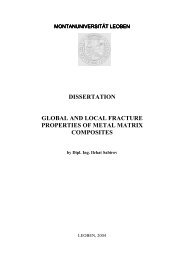Scientific Advisory Board - Erich Schmid Institute
Scientific Advisory Board - Erich Schmid Institute
Scientific Advisory Board - Erich Schmid Institute
You also want an ePaper? Increase the reach of your titles
YUMPU automatically turns print PDFs into web optimized ePapers that Google loves.
ERICH SCHMID INSTITUTE OF MATERIALS SCIENCE<br />
constant volume approximation up to approximately 2% strain, then dramatically increasing<br />
after (fig. 16a). the faster growth can be attributed to the lack of ductility because of the small<br />
grain size. Upon unloading and after a 24hrs period, the amount of resistance recovery varies<br />
depending on the maximum applied strain. for a maximum strain of 5% the resistance of the<br />
film after straining is lower than originally measured. the resistance recovery is attributed to a<br />
reduction of the defect density and grain boundary defects as well as crack closure (fig. 16b).<br />
it was found that a compressive stress was measured in the film at a load of 0n (approximately<br />
-400 mpa) and an assumed constant compressive stress after removal from the tensile stage.<br />
plastic deformation in the cu film causes the compressive stress and the viscoelastic behavior<br />
of the pet is the reason behind the continued recovery after straining. in order to properly<br />
characterize and compare the electro-mechanical behavior of metal films on polymers for<br />
flexible electronic applications, not only the behavior at a maximum stress or strain should be<br />
examined, but also during unloading and at least several hours afterward.<br />
Decrease in Adhesion with Altered Interface Microstructure<br />
titanium layers are used to promote adhesion between polymer substrates for flexible<br />
electronics and the cu or Au conducting lines. good adhesion of conducting lines in flexible<br />
circuits is critical in improving circuit performance and increasing circuit lifetime. nominally 50<br />
nm thick ti films on polyimide (pi) are investigated by fragmentation testing under uniaxial<br />
tensile load in the as-deposited state, at 350°c, and after annealing. the cracking and buckling<br />
of the films show clear differences between the as-deposited and the thermally treated samples,<br />
cracks are much straighter and buckles are smaller following heat treatment. these changes<br />
are correlated to a drop in adhesion of the samples following heat treatment. Adhesion values<br />
are determined from the buckle dimensions using a total energy approach. cross-sectional<br />
transmission electron microscopy (tem) of the ti/pi interface found evidence of a 5 nm thick<br />
interlayer between the largely columnar ti and the amorphous pi. the tem study infers that the<br />
difference in adhesion caused by heat treatment of these ti films is linked to the crystallisation<br />
of an interlayer between the ti and pi (fig. 17). the implications of this for the processing, use<br />
and lifetimes of flexible electronic circuits are extensive. Additionally, this greater understanding<br />
of how ti acts as an effective adhesion layer between polymers and metallisation materials<br />
such as Au and cu could lead to more failure-resistant, flexible circuitry.<br />
Fig. 17 Cross-sectional TEM micrographs of the Ti/PI interface of an as-deposited sample(left)<br />
and (right) and a 350°C tested sample.<br />
<strong>Scientific</strong> RepoRt 2012 page 31

















